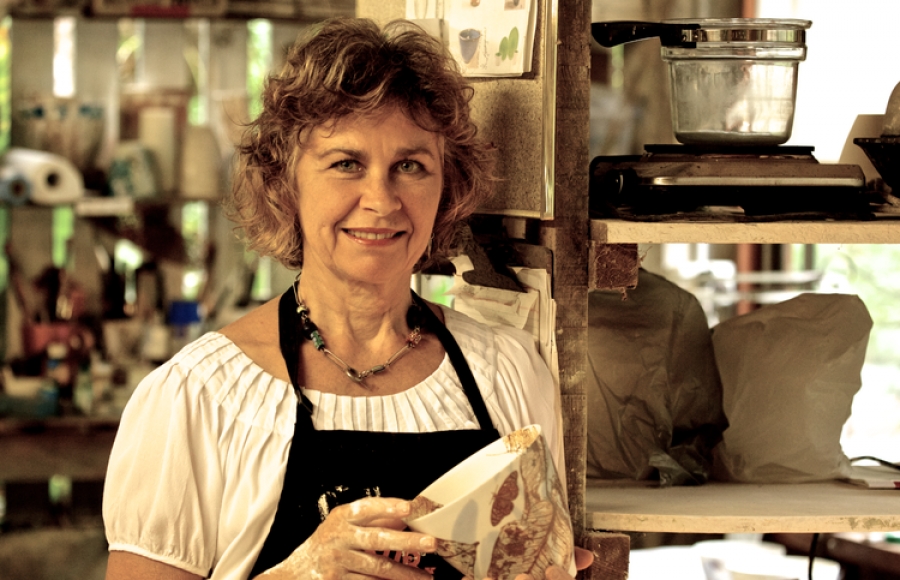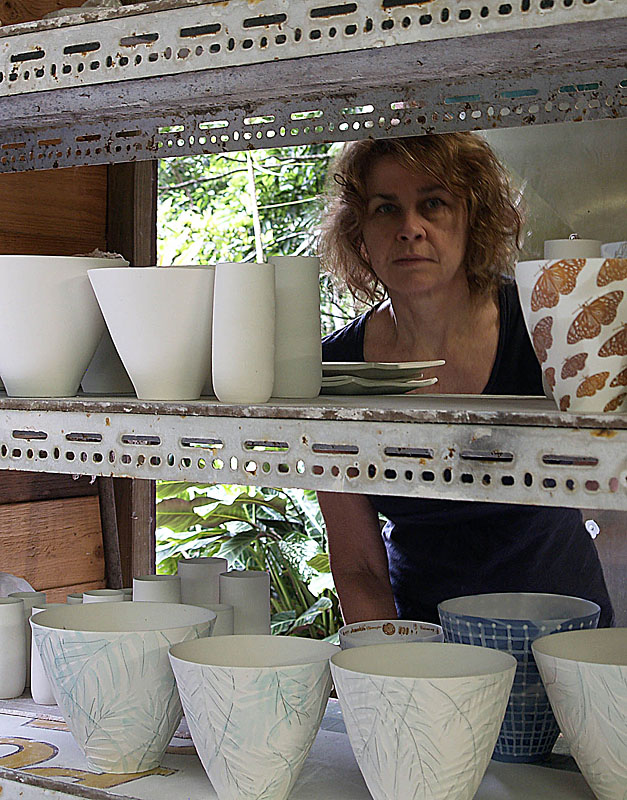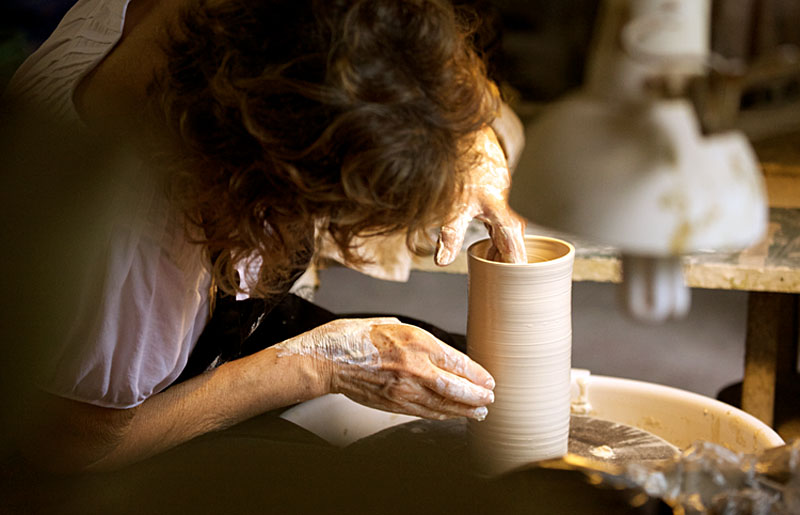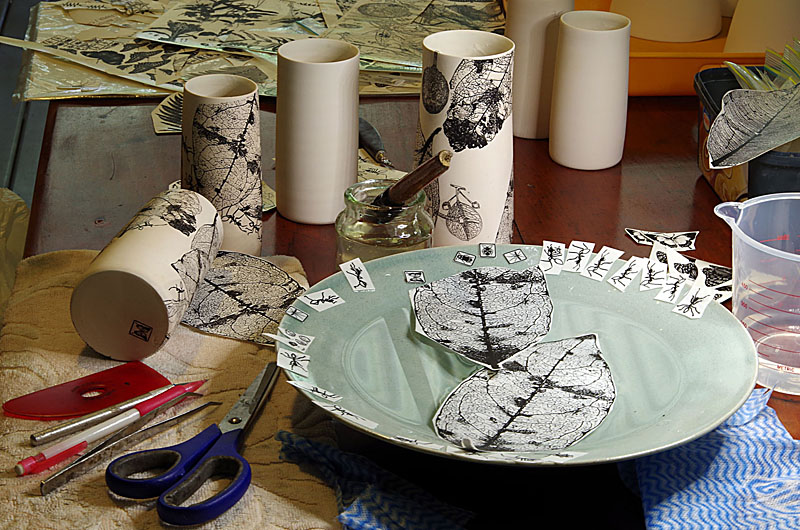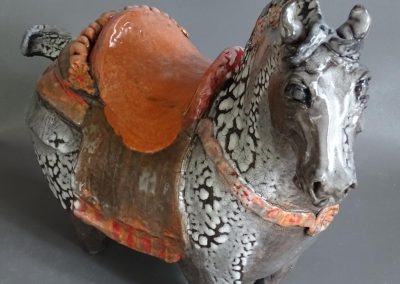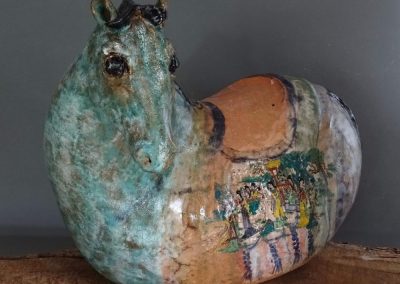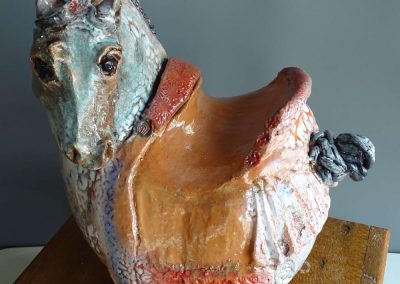Mostly self taught, Mollie Bosworth completed a Diploma of Art (ceramics) at the Australian National University in 2003. She has won several awards for her work including the Townsville National Ceramic Award, the Siliceous Award for ceramic excellence and an Honourable Mention in the 3rd International Ceramic Competition in Korea.
Can you describe your current style
Currently most of my ceramic work is vessel based, wheel thrown using porcelain and a variety of surface techniques.
How did you get started
I did some clay electives in high school and the some clay work in teachers college and continued doing pottery adult education courses.
Who was a teacher that had a strong influence on you
I’m mostly self taught, but during the 1980’s I attended Flying Arts workshops and did several with Gwyn Hanssen Pigott. That was the first time I saw fine throwing and heard her describe details of her aesthetic.
What styles appealed to you when you were starting out
I did a variety of hand building in stoneware until I started to learn to throw. There were lots of brown glazes in use, all based on Japanese stoneware glazes.
Were there any other influences from Australian or overseas artists/ceramicists
In 1979/80 I was in the UK and often visited museums like the V&A and the Craft Potters Association. I noticed then the use of porcelain clay and I liked Lucie Rie’s work.
When I came home, it was still difficult to find porcelain clay. I purchased books on porcelain particularly “Porcelain” by Peter Lane (UK) and was lucky to go to his workshop in Mackay.
I attended the McGregor Summer School in the early 1990s and did a workshop with Colin Pearson (UK) whose work I really admired.
What kind of potter are you – how would you describe the pottery you do
I mostly make non functional vessel based work with a focus on materials and processes.
Which is more important to you – exhibitions, commercial (for sale) or artistic – for your own exploration and pleasure
Making work for exhibitions and exploring directions I’m really interested in. I don’t do orders or commissions now. I have my work for sale and make a few lines with sales in mind.
What is the role of the following in your current work:
Galleries
Apart from the Kuranda Arts Cooperative Gallery, I have work in only a few galleries. It has been difficult to find galleries I can work with. Distance can be a big problem if work is on consignment.
Online
An online presence is especially important to me as I live so remotely from major population centres. I have a website which is outmoded and I’m currently working with a website designer to develop a new website.
I’ve had a Facebook page for ceramics for a few years, but since starting Instagram in January I’m getting farmore response from Instagram.
I get some sales and opportunities from followers and enjoy networking with a range of people who, because of distance, I wouldn’t usually get to meet.
Exhibitions
I participate in quite a few group exhibitions throughout Australia and enter competitions. I’m working on a solo exhibition for September next year which I hope will push my work forward.
Works will be across two mediums ceramic and cyanotype.
Commissions
Always become too difficult and I prefer not to do them.
Do you see this sales mix changing over the next 5 years for you or other professional potters
There seems to be less suitable galleries for ceramics. I’m hoping my online sales will increase with my new mobile friendly website, but I think ceramics do need to be seen and touched.
Your Studio – where is it
It is under my house in Kuranda.
Is it ideal for you
The size is good now. I had an extension added a few years back for the gas kiln and it gives me more room for a packing area.
What would you change if you could
I still haven’t got the studio totally sealed. I will be working on this soon as there are too many rats and snakes going through at night often damaging work and knocking things off shelves.
What equipment is crucial to your work and business
A Shimpo wheel, a pugmill, gas kiln and SLR camera. I would like to add a small electric kiln as well.
How would you describe the current state of ceramics in Australia
I like work that is skillfully crafted and not a lot of the wonky ‘handmade look’ work that is around. It is difficult to make a living, but I think if you know your target market, you can be successful.
In your experience, who is a typical buyer for your work – is there such a thing!
Usually female, with disposable income.
Do you think Australian buyers are educated in what makes ceramics valuable (Internationally and nationally)
No, I think they still see ceramics as second in value to 2D artwork. They are also confused about function.
What role should an artist play in this
I point out to my customers the time spent in development and the uniqueness of the work. I still think ceramics is undervalued generally.
What do you see as the most important role for organisations such as CAQ and TACA in your professional development and in promoting ceramics within the craft and to the wider public
The CAQ professional development workshops are a good idea but workshops are difficult to access easily for remote ceramicists. The exhibition opportunities that both organisations provide is helpful in gaining wider exposure and educational for emerging artist. TACA’s Open Studio idea seemed like a good idea as well but in areas of small population it isn’t cost effective. The newsletters of both organisations are helpful. They keep ceramicists informed of current opportunities and happenings in ceramics

